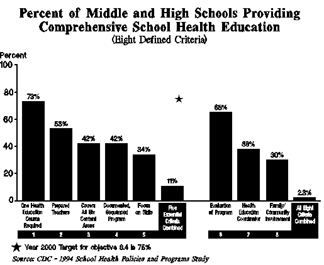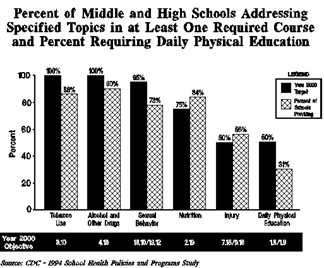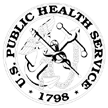
In a review of the Healthy People 2000
objectives for Priority Area 8: Educational and Community-Based
Programs, the Centers for Disease Control and Prevention in
co-lead with the Health Resources and Services Administration
organized an overview of progress on the objectives around three
areas: progress in identifying data sources for priority area
objectives, building support for school health education, and
initiatives and trends in community health promotion.
8.2 In 1992, 86 percent of the total
population (aged 18-24) had completed high school; the high
school completion rate was 62 percent for Hispanics and 82
percent for Blacks. Data for 1994 show little or no change for
any group. The year 2000 objective is to increase the high school
completion rate to 90 percent. The objective is based, in part,
on studies which have shown a correlation between high school
completion and a reduction in risks for multiple problem
behaviors and improved mental and physical health. During the
1995 Midcourse Revisions, "high school graduation" was
replaced with "high school completion," to include
students who complete high school with alternative credentials.
The U.S. Department of Education modified the age cohort for high
school completion from 19-20 years to 18-24 years. The objective
is now aligned with measures used by the U.S. Department of
Education to track national education goals.
8.3 This objective aims to achieve
access to high quality and developmentally appropriate preschool
programs for all disadvantaged children and children with
disabilities. It is consistent with the National Education Goal
that addresses preschool child development programs. In 1995, 54
percent of low-income children had received at least 1 year of
Head Start services and 63 percent of disabled 3-5 year olds were
enrolled in preschool.
8.4 The year 2000 target for this
objective is to increase to at least 75 percent the proportion of
elementary and secondary schools which provide comprehensive
school health education. This objective was modified during the
1995 Midcourse Revisions to replace the term "quality school
health education" with "comprehensive school health
education." Baseline data for this objective are from CDC's
School Health Policies and Program Study (SHPPS). In 1994, 11
percent of middle and high schools met 5 essential criteria of
comprehensive school health education and 2.3 percent met all 8
criteria. The essential criteria include having a documented,
sequential program; requiring at least one health education
class; providing instruction in six behavioral areas; focusing on
skill development; and employing adequately trained teachers.
8.5 In the baseline school year 1989-90,
a survey sponsored by the American College Health Association
showed that 20 percent of post-secondary institutions provided
health promotion programs for students, faculty, and staff. The
year 2000 target is 50 percent. Although there has been no update
of the baseline, a proxy measure of the objective is available
from the College Youth Risk Behavior Survey, which monitors
critical health risk behaviors among college students. This
survey revealed that, in 1992, the proportion of college students
aged 18-24 who received health information from their college
varied by topic area, ranging from 21 percent for information
about suicide prevention to 60 percent for information about
alcohol and drug use.
8.9 In 1994, the proportion of people
aged 10 and older who discussed health issues with family members
at least once during the preceding month was 83 percent,
exceeding the year 2000 target of 75 percent. The proportion of
those who discussed specific health topics ranged from 33 percent
for illegal drugs to 67 percent for nutrition. Data to measure
this objective were derived from the National Health Interview
Survey.
8.10 This objective is to establish
community health promotion programs which address at least three
of the Healthy People 2000 priority areas and reach at least 40
percent of each State's population. A 1992-93 survey by the
National Association of City and County Health Officials (NACCHO)
revealed that 90 percent of local health departments in 35 States
provided services that addressed three or more priority areas.
However, the NACCHO survey does not offer data regarding the
proportion of the population served by these programs.
8.11 This objective is to increase to at
least 50 percent the proportion of counties which have
established culturally and linguistically appropriate community
health promotion programs for racial and ethnic minority
populations. No data are currently available to track the
objective. CDC and the PHS Office of Minority Health are working
to develop a methodology for measurement.
8.13 In the Nation's top 20 television
markets, 100 percent of local television network affiliates
report being partners with one or more community organizations
around one of the health problems addressed by the Healthy People
2000 objectives, surpassing the year 2000 target of 75 percent.
These data come from a CDC-sponsored survey conducted in 1995-96.
8.14 This objective aims to increase to
at least 90 percent the proportion of people who are served by
local health departments which are effectively carrying out the
core functions of public health. The 1992-93 NACCHO survey
provides some data relevant to this objective. Of the local
health departments reporting, 84 percent provided health
education, 96 percent immunizations, 64 percent prenatal care,
and 30 percent primary care.


HIGHLIGHTS
- The growing Healthy Cities and Healthy
Communities movement is involving communities in the
planning and assessment of health education and health
promotion programs.
- The U.S. Department of Education provides
only 6 percent of funding for public schools; State and
local resources are predominant. Proposed increases in
funding to public schools are being met with resistance
by taxpayers. These limitations present a challenge for
promoting and implementing comprehensive school health
education.
- "Full-service schools" are a new
educational initiative. These schools offer a variety of
educational, counseling, social, and health services to
families in one location. Some of these services are
available on a 24-hour basis.
- A quilt made in Garrett County, Maryland,
was on display in the Progress Review conference room and
had been featured at the county fair. Multi-colored
panels depicted the multiple sites for community health
promotion activities, including schools, day care
centers, worksites, churches, and health care facilities.
The quilt itself was a symbol of the interconnectedness
of these activities and issues.
- Progress has been made in identifying and
utilizing national data sources for objectives in this
priority area. However, it remains a challenge to
translate these objectives into relevant State, local and
private sector measures to guide program planning and
assessment.
FOLLOW-UP
- Increase collaboration with the Department
of Education to strengthen and support school health.
- Promote the concept of "full
service" schools, which provide families in the
community with health and other services.
- Enable communities to address their
highest priority needs by identifying sources of Federal
and private funding and by merging diverse sources of
categorical funding for school and community health
education and health promotion.
- Explore ways the Public Health Service
with its partners can support and enhance community
efforts to solve problems of disease prevention and
health promotion.
- As managed health care plans serve greater
numbers of Americans, study the implications this will
have for school-based health services.
- Seek to ensure that educational and
community-based health promotion programs are made
available to all populations in the community, and engage
the cooperation of businesses, law enforcement agencies,
and the faith community in assuring access to and the
cultural competency of such health programs and services.
- Develop data strategies to help States and
communities better utilize existing data methodology and
data sets to measure health indicators important to them.
PARTICIPANTS
Administration for Children, Youth and Families
American Cancer Society
American College Health Association
American Hospital Association
American Public Health Association
California Department of Health Services
Centers for Disease Control and Prevention
Department of Education
GenCare Health Systems
Health Resources and Services Administration
Garrett County (MD) Health Department
Indian Health Service
Louisiana Department of Health and Hospitals*
Maine Bureau of Health**
National Association of County and City Health Officials
National Institutes of Health
Office of Disease Prevention and Health Promotion
Office of Minority Health
Office of Public Health and Science
Office of the Surgeon General
Pan American Health Organization
Partnership for Prevention
Society for Public Health Education
* Representing also the
Association of State and Territorial Health Officials
**Representing also the Association of State and Territorial
Directors
of Health Promotion and Public Health Education


Philip R. Lee, M.D.
Assistant Secretary for Health
Back to Progress Review Page